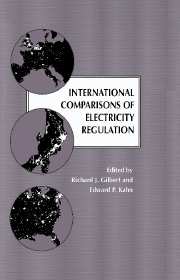Book contents
- Frontmatter
- Contents
- Preface
- International Comparisons of Electricity Regulation
- 1 Introduction: International comparisons of electricity regulation
- 2 Regulation, public ownership and privatisation of the English electricity industry
- 3 How should it be done? Electricity regulation in Argentina, Brazil, Uruguay, and Chile
- 4 From club-regulation to market competition in the Scandinavian electricity supply industry
- 5 Competition and institutional change in U.S. electric power regulation
- 6 The Japanese electric utility industry
- 7 Regulation of the market for electricity in the Federal Republic of Germany
- 8 The evolution of New Zealand's electricity supply structure
- 9 Regulation of electric power in Canada
- 10 The French electricity industry
- 11 The Yugoslav electric power industry
- Index
2 - Regulation, public ownership and privatisation of the English electricity industry
Published online by Cambridge University Press: 21 March 2010
- Frontmatter
- Contents
- Preface
- International Comparisons of Electricity Regulation
- 1 Introduction: International comparisons of electricity regulation
- 2 Regulation, public ownership and privatisation of the English electricity industry
- 3 How should it be done? Electricity regulation in Argentina, Brazil, Uruguay, and Chile
- 4 From club-regulation to market competition in the Scandinavian electricity supply industry
- 5 Competition and institutional change in U.S. electric power regulation
- 6 The Japanese electric utility industry
- 7 Regulation of the market for electricity in the Federal Republic of Germany
- 8 The evolution of New Zealand's electricity supply structure
- 9 Regulation of electric power in Canada
- 10 The French electricity industry
- 11 The Yugoslav electric power industry
- Index
Summary
Introduction
The privatisation of the Electricity Supply Industry (ESI) of England and Wales not only transferred ownership from the public to the private sector but must rank as one of the most ambitious attempts anywhere to introduce competition into a normally vertically integrated natural monopoly. The high-tension transmission grid and the low-tension distribution system are classic examples of natural monopolies in which the costs of duplication make competition between alternative systems uneconomic. Between the date of nationalisation in 1948 and privatisation in 1990, the industry consisted of two vertically integrated, state-owned segments: generation and high-tension transmission were under the control of the Central Electricity Generating Board (CEGB) and its precursors, whereas distribution and supply were under the control of twelve Area Boards (ABs), which received electricity from the CEGB under the Bulk Supply Tariff. Both the CEGB and the Area Boards were represented on the coordinating body of the Electricity Council.
Recent theoretical discussions of regulation and privatisation typically work within a Principal-Agent framework and assume the existence of a single principal (normally taken as the state or party in power), with a coherent and well-defined objective and substantial powers to design systems of monitoring and incentives to best achieve that objective, constrained by the opacity and asymmetry of information about the regulated enterprise and the conflicting objectives of the owner, the manager, or both. A more realistic assessment would be that at each moment natural monopolies are constrained by a historically given politicoeconomic balance of interests that circumscribe the actions available to the principal and severely limit the possible changes in the system of regulation and the design of incentives.
- Type
- Chapter
- Information
- International Comparisons of Electricity Regulation , pp. 25 - 81Publisher: Cambridge University PressPrint publication year: 1996
- 10
- Cited by



